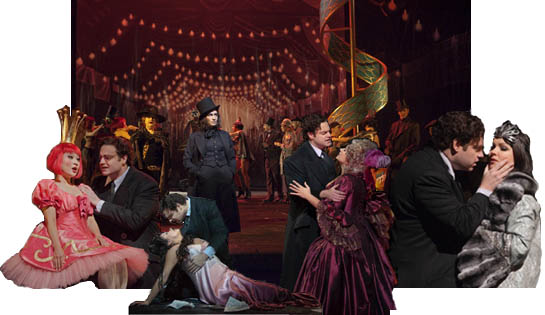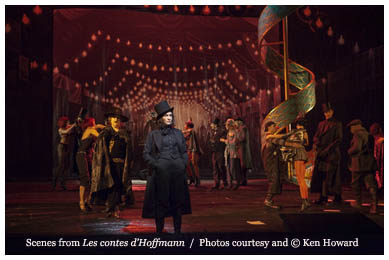Beyond superlative... glorious artistry... a delightful
opera
that is ironically about a man on the edge of losing his soul.
by Karen Shearer Voorhees*

Jacques Offenbach's' Les contes d'Hoffmann / a Metropolitan
Opera production
stage direction: Bartlett Sher / music direction: James Levine
photos courtesy and © Ken Howard
We are used
to excellence from the New York Metropolitan Opera, but its
2009-10 season production of Tales of Hoffmann was beyond superlative.
This viewer would gladly have sat through it again the same
day. The exuberant, over-the-top staging struck some false notes,
but these were few and far between. They could not dim the delightfulness
of this opera that is, ironically, about a man on the edge of
losing his soul.
The magic of the Met Operaâs ongoing HD Simulcast program
allowed this traveling viewer to watch Tales of Hoffmann last
December far from home, it in a theater near Palm Springs, California.
The program seems to be attracting a rapidly growing audience
around the world; the show in Palm Springs was sold out. (Most
of the audience looked over fifty, though; the simulcast program
may not be drawing younger generations to opera). This broadcast
had none of the technical problems that have marred some previous
ones, such as the repeatedly fuzzed sound in Aida.
The only technical quibble would be the frequent camera close-ups
that sometimes felt intrusive.
The young soprano Kathleen Kim, who played the mechanical doll
Olympia, was a revelation. Likewise the new tenor Joseph Calleja
who sang the role of Hoffman for the first time, and mezzo Kate
Lindsey as the androgynous Niklausse. The audience gave them
well-deserved roaring ovations. Other singers were also at the
top of their form, including the superstar Anna Netrebko who
appeared as both Stella and the doomed Antonia.
The libretto (by Barbier and Carré) is based loosely
on several of the short stories written by E. T. A. Hoffmann
early in the nineteenth century. Hoffmann had lived a life of
excess, and died at age 46 of alcoholism and syphilis. (His
life helped create the cliché of the tragic romantic
artiste). This operaâs florid libretto and score are based
as much on E. T. A. Hoffmannâs life as on his tales. Hence
the name of the operaâs protagonist, and of the opera
itself.
The composer Offenbach died in 1880 before finishing the score
for Tales of Hoffmann. There is no one authoritative version,
so different productions can vary hugely. Part of the fun in
seeing this opera staged is in comparing the differences. The
version assembled for this Met production deliberately emphasizes
the psychological depths that were such a notable part of E.
T. A. Hoffmannâs original stories, and it heightens the
ambiguities. In other productions the role of Hoffmann has been
played as moody or morbid. Here he is played warmly and openly
(matching Callejaâs clear, golden voice), and therefore
easily deluded. By way of balance, Hoffmanâs muse/companion
Niklausse has become darker and more menacing. Inspired staging
makes it clear that s/he is fully in league with the demonic
Lindorf, which is not the case in other versions. Niklausse
and Lindorf collude to ensure that Hoffman is always thwarted
in love.
Among the many brilliant staging elements is the addition of
Hoffmannâs table and typewriter downstage right all through.
Hoffmann begins and ends the opera here, and returns to it often
during the tavern scenes and the three love stories. Along with
other elements of staging, this heightens the surreal ambiguity:
How much of this drama is external reality? How much of it is
an inner drama between aspects of Hoffmannâs own psyche?
The story line works at both levels throughout. In this way
it is much like the hit Broadway musical The Phantom of the
Opera, which was clearly inspired in large part by this opera.
 As
the opera begins we are in a tavern in Nuremburg. Hoffman is
carousing with friends while waiting for his beloved Stella
to arrive. To entertain the crowd he begins a song about a pathetic
dwarf named Kleinzach. This short but essential ballad is a
reference to E. T. A. Hoffmann. Like Kleinzach, the original
writer of these Tales had been abnormally short with a very
large head, very small hands and feet, and facial tics. He had
bitterly felt like an outcast and freak his whole life. This
Met productionâs brilliantly staged Ballad of Kleinzach
makes a deep impression, as it must, for it will be crucial
again at the end of the opera. As
the opera begins we are in a tavern in Nuremburg. Hoffman is
carousing with friends while waiting for his beloved Stella
to arrive. To entertain the crowd he begins a song about a pathetic
dwarf named Kleinzach. This short but essential ballad is a
reference to E. T. A. Hoffmann. Like Kleinzach, the original
writer of these Tales had been abnormally short with a very
large head, very small hands and feet, and facial tics. He had
bitterly felt like an outcast and freak his whole life. This
Met productionâs brilliantly staged Ballad of Kleinzach
makes a deep impression, as it must, for it will be crucial
again at the end of the opera.
The staging of the first of the three Tales piles on the “romantic”
excess. This reviewer loved it all. Dr. Spalanzani costumed
as Dr. Mengele! The gooey eyeballs! The descending spiral stairway,
painted as a dragon, that seemed to devour Hoffmann! The bizarre
outfits on everyone! And above all, the glorious, festive music!
Hoffmann, here an eager student of science, is complicit in
his own deception. He willingly puts on the glasses of illusion
that make the mechanical doll Olympia appear to be a living
woman. He falls in love with a thing that isnât even alive.
When the two doctors tear the doll apart at the end of the scene
(quarreling over money, significantly), Hoffmann is shattered.
While perhaps the most lyrically beautiful, the score for the
second Tale is more muted than the other two. The staging is
appropriately spare, even stark, in powerful contrast to the
scenes before and after. Antonia is ill and must conserve her
strength. She must choose between married life and a brilliant
public career as a singer. Hoffmann, now a serious musician,
seems about to have a happy, fulfilled “bourgeois”
life with her, but Lindorf and Niklause prevent this by driving
Antonia to death. E. T. A. Hoffmannâs hatred of bourgeois
life and culture is reflected here in a duet between Antonia
and Lindorf.
The exquisite Barcarole that begins the third Tale does not
take place with the usual gondola ride through the canals of
Venice. Instead we are indoors at an orgy in the salon of the
courtesan Guilietta. Nearly naked dancers writhe in choreographed
coitus. (Here was one of those times when camera close-ups undercut
the stage magic. The intended eroticism was lost in vistas of
bulging calf muscles of monstrous size).
Now a cynical man-of-the world, Hoffman insists that he is immune
to love. Nonetheless he falls hard for the courtesan Giulietta
the moment she turns her wiles on him. Goaded by Lindorf, who
has bribed her with a magnificent diamond, Giulietta steals
Hoffmannâs shadow—a metaphor for loss of oneâs
soul. In this version, unlike some others, Hoffman doesnât
get his shadow back when Giulietta drops him. Niklausse helps
lure Hoffmann into this situation, then helps him escape after
he kills a rival in a duel.
The opera ends with a final short scene in the tavern where
it began. By now Hoffmann is too drunk to respond to Stella
when she arrives. She leaves with Lindorf. Aware that he has
lost her for good, Hoffmann erupts in self-hatred and identifies
himself with the defective, deformed dwarf Kleinsach. Niklausse
gently guides him back to his typewriter and urges him to fulfill
his true calling as poet.
Hoffman has been “saved” from a fulfilled relationship
with a woman. Will he instead use his energies to fulfill a
“higher” calling as an artist? Will he transcend
by distilling his misery into poetry? Or is he too far gone
in alcoholism? Will he disappear into a bottle? The luminous
hymn with which the opera ends implies transcendence. But the
behavior of Niklausse, who has encouraged his drinking throughout,
and the loss of his shadow, imply that alcoholism has won. The
ambiguity at the operaâs end is total.
Or will the protagonist do both, like his namesake E. T. A.
Hoffman, who died of his excesses after an astonishingly brilliant
and productive artistic career? We donât know. We leave
the theater drunk on glorious artistry.
BUY
Tales of Hoffmann: on
DVD on
CD mp3
download
*Karen Shearer Voorhees was born in Pennsylvania and grew up
in California near the San Francisco Bay Area. Her early fascination
with Tolkien's "Lord of the Ring" cycle led her to
become a Medievalist. In college she soon realized that Wagner
had drawn on the same mythological material for his Ring
Cycle as Tolkien had--in fact, Wagner was one of Tolkiens
greatest inspirations. From Wagner her love of opera expanded
through Mozart to the rest of the greats. She received a Ph.D
in History of Art and Medieval Studies from UC Berkeley in 1988,
but withdrew from academia to pursue writing, editing, and meditation.
She now lives with her husband on the north coast of California,
surrounded by redwood trees, in view of the Pacific Ocean.
Opening music is excerpted from the famous Barcarole in Act Two
of Tales of Hoffmann, taken from the London recording
with Richard Bonynge conducting the L'Orchestre de las Suisse
Romande with Placido Domingo as Hoffmann and Dame Joan Sutherland
as Olympia, Giulietta, Antonia, and Stella.
back
to TOP |
|
PAUSE
/ STOP
Opening music
Tales
of Hoffmann
on
DVD
on
CD
mp3
download
VISIT...
FanFaire's
all-new
AMAZON aSTORE
AUDIOFILES
AUDIENCE
ETIQUETTE
MUSICPLANNER
PRESS
ROOM
NEW
RELEASES
FOOD
& MUSIC
SITE
MAP

USA
UK
DE FR
Buy
sheet music

Sign
up:
EMAIL
UPDATE
FREE
CD!

STORE

Opera
News QUIZ

Rough
Guide QUIZ
back
to TOP
VISIT...
FanFaire's
all-new
AMAZON aSTORE
|